Cotoneaster bonsai styles offer diverse beauty. Each style brings a unique charm.
Table of Contents
ToggleBonsai enthusiasts cherish the cotoneaster’s adaptability. It’s perfect for crafting stunning bonsai trees. Known for its glossy leaves and vibrant berries, cotoneaster is popular among beginners and experts alike. Its small leaves make it ideal for detailed designs. With patience, you can shape it into breathtaking forms.
There are various styles to explore, each with distinct features. From informal upright to cascade, the possibilities are endless. Whether you’re new or experienced, cotoneaster bonsai provides a rewarding journey.
Dive into the world of cotoneaster bonsai styles and discover your favorite. Transforming a simple plant into art is a delightful challenge. Let’s explore the captivating styles that cotoneaster bonsai offers.
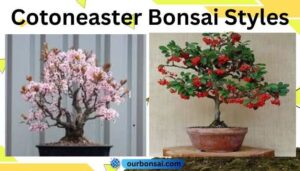
Cotoneaster Bonsai Styles
Cotoneaster bonsai styles offer diverse shapes and forms, perfect for creative cultivation. Popular choices include cascade, informal upright, and windswept designs. Each style highlights the plant’s delicate leaves and vibrant berries, adding charm to any bonsai collection.
Cotoneaster bonsai styles capture the imagination of enthusiasts worldwide. These miniature trees, with their charming appearance, offer diverse styling options. Whether you’re a seasoned bonsai artist or a curious beginner, exploring different styles can be exciting.
Informal Upright Style
This style mirrors trees shaped by nature’s elements. It features a gently curved trunk, mimicking wind-swept trees in the wild. The branches spread out in a natural pattern, giving it a relaxed look.
Cascade Style
The cascade style evokes the image of trees clinging to a cliff. Here are some key characteristics:
- Trunk direction: Grows downwards, resembling a waterfall.
- Pot placement: Planted in a deep pot for stability.
- Branch growth: Tips of branches often dip below the pot’s base.
Semi-cascade Style
Imagine a tree growing on a riverbank. The semi-cascade style embodies this scenario. Its trunk bends slightly, with branches that gently droop. This style is both graceful and balanced.
Broom Style
Broom style bonsai resemble trees found in open fields. They have an upright trunk with branches fanning out like a broom. It creates a full, rounded canopy, often seen in deciduous trees.
Literati Style
The literati style is a celebration of simplicity and elegance. It features:
- Trunk appearance: Long and slender with minimal branches.
- Design focus: Emphasizes trunk movement and grace.
- Branch arrangement: Sparsely placed, highlighting the trunk’s form.
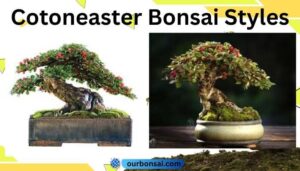
Best Cotoneaster Bonsai Styles
Explore the charm of Cotoneaster bonsai with styles like cascade, upright, and informal. These styles highlight the plant’s beautiful berries and delicate foliage. Perfect for beginners, Cotoneaster bonsai offers an elegant and manageable addition to any collection.
The art of bonsai transforms trees into miniature wonders. Cotoneaster bonsai, with its lush foliage and bright berries, offers various captivating styles. Let’s explore some of the best Cotoneaster bonsai styles to inspire your creative journey.
Informal Upright Style
The informal upright style offers a natural and elegant look. It mimics trees found in nature, with gentle curves. This style suits beginners due to its forgiving shape.
Cascade Style
The cascade style is dramatic and eye-catching. This style features a trunk flowing downward, like a waterfall. Key aspects to consider:
- Trunk movement: The trunk should curve gracefully.
- Pot choice: Use deeper pots to support the trunk.
- Branch placement: Maintain balance with strategic branch positioning.
Slanting Style
In the slanting style, the trunk leans at an angle. It creates a dynamic appearance, as if shaped by the wind. This style adds movement to any bonsai display.
Broom Style
The broom style presents a rounded, broom-like canopy. A straight trunk supports a full crown of branches. Its balance and symmetry are visually appealing.
Literati Style
The literati style is minimalist and artistic. This style highlights the beauty of the trunk. Important elements include:
- Sparse foliage: Focus on trunk elegance.
- Tall pot: Enhance the tree’s vertical impact.
- Simple design: Less is more, highlighting natural beauty.
These styles offer a range of expressions for Cotoneaster bonsai. Whether you’re a beginner or experienced, there’s a style for you. Let your creativity flourish with these inspiring bonsai forms.
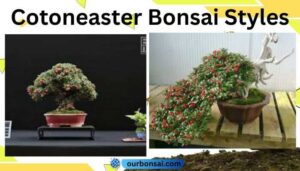
Cotoneaster Bonsai Styles For Beginners
Exploring Cotoneaster bonsai styles offers beginners a variety of creative possibilities. Popular choices include informal upright, cascade, and semi-cascade styles. Each style highlights the natural beauty and adaptability of the Cotoneaster plant.
Cotoneaster bonsai trees are perfect for beginners. They are easy to shape and care for. These trees offer various styles to suit every taste. Let’s explore the styles that are ideal for those new to bonsai.
Informal Upright Style
This style is a favorite among beginners. The tree has a gentle curve, making it look natural.
- Graceful appearance: The informal upright style gives the tree a relaxed look.
- Easy to shape: Beginners can easily guide the tree’s growth.
- Natural elegance: The curves create a pleasing visual effect.
Cascade Style
Cascade style brings a unique charm to bonsai. The branches grow downward, resembling a waterfall.
The tree seems to spill over the pot’s edge, creating a dramatic effect. Beginners enjoy this style for its striking appearance.
Broom Style
Broom style is simple and neat. The tree has a straight trunk with branches spreading evenly.
- Symmetrical look: This style offers a balanced and tidy appearance.
- Easy maintenance: It’s simple to keep the branches in shape.
- Perfect for starters: Provides a straightforward way to learn bonsai care.
Windswept Style
Windswept style captures the essence of nature’s force. The branches grow in one direction as if blown by the wind.
This style is intriguing and dynamic. Beginners love how it mimics nature’s power.
Group Planting Style
Group planting involves several trees in one pot. It creates a miniature landscape.
- Multi-tree arrangement: Offers diversity and complexity in design.
- Creative expression: Allows for artistic layout of trees.
- Beginner-friendly: Encourages exploration of bonsai techniques.
Best Cotoneaster For Bonsai
Cotoneaster bonsai styles offer diverse shapes and sizes, perfect for both beginners and experts. Its small leaves and bright berries enhance visual appeal. The plant’s adaptability makes it ideal for creating stunning bonsai displays.
Growing a cotoneaster bonsai can be a delightful journey for plant enthusiasts. These charming plants bring a touch of nature to any space. Their adaptability makes them a popular choice for bonsai creation. But, not all cotoneasters are equal for bonsai art.
Selecting the best variety can enhance your experience and results.
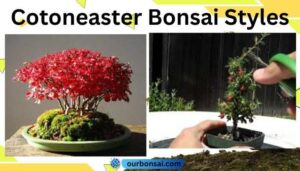
Cotoneaster Microphyllus
This variety is a favorite among bonsai artists. It offers several benefits:
- Small Leaves: Perfect for maintaining scale in bonsai form.
- Hardy Nature: Adapts well to various climates and conditions.
- Attractive Berries: Adds color and visual interest to your bonsai.
Cotoneaster Horizontalis
Cotoneaster horizontalis is another excellent choice for bonsai. This variety offers unique features that make it stand out.
Its natural growth pattern resembles a fishbone. This characteristic can create intriguing bonsai shapes. Additionally, it boasts glossy leaves and vibrant berries. These features add visual appeal year-round. Its resilience and ease of care make it ideal for beginners.
Cotoneaster Dammeri
Cotoneaster dammeri is known for its low-growing habit. Its characteristics include:
- Creeping Growth: Provides unique design possibilities.
- Prolific Flowering: Produces small, charming flowers.
- Drought Tolerance: Thrives in less than ideal watering situations.
Cotoneaster Simonsii
This variety is often selected for its robust growth. It is well-suited for bonsai creation.
With its upright structure, cotoneaster simonsii can be shaped into elegant forms. It features small, rounded leaves that maintain proportion. Its bright red berries add a pop of color. This variety is resilient and easy to care for, making it a good choice for beginners and experts alike.
Cotoneaster Franchetii Fiche Technique
Explore the elegance of Cotoneaster Franchetii in bonsai styles. This plant offers flexibility in shaping. Its delicate branches and vibrant berries enhance aesthetic appeal, perfect for creating stunning bonsai displays. Ideal for beginners and experienced enthusiasts alike.
Cotoneaster Franchetii Bonsai brings elegance to your garden space. This variety is celebrated for its graceful, arching branches and vibrant berries. Perfect for bonsai enthusiasts, it offers a unique blend of beauty and resilience. Delve into its technical details to discover its charm and adaptability.
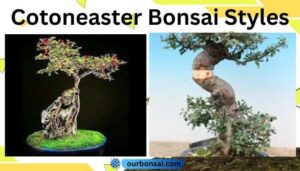
Natural Habitat
Cotoneaster Franchetii thrives in varied environments. Originating from the Himalayas, it adapts to different climates:
- Range: Found in China, Nepal, and Bhutan.
- Climate: Prefers temperate regions with moderate rainfall.
- Soil: Grows well in well-drained soil types.
Growth Characteristics
Understanding its growth helps in effective styling. Let’s explore its features:
- Height: Reaches up to 3 meters in the wild.
- Leaves: Evergreen, glossy, and elliptical.
- Flowers: Small, white to pink blooms in spring.
Bonsai Styling Techniques
Creating a Cotoneaster Franchetii bonsai involves specific techniques. Here are some tips:
- Pruning: Regular trimming encourages branch development.
- Wiring: Use wire to shape branches carefully.
- Soil Mix: Use a mix that retains moisture but drains well.
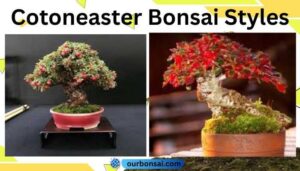
Care And Maintenance
Proper care ensures a healthy bonsai. Here are key points to remember:
- Watering: Keep the soil consistently moist.
- Fertilizing: Feed with balanced fertilizer monthly.
- Pest Control: Watch for aphids and treat promptly.
Cotoneaster Bonsai Styles, video!
Seasonal Changes
Cotoneaster Franchetii showcases beauty through seasons. Each change brings unique aspects:
- Spring: Blooms appear, adding color.
- Autumn: Berries turn vibrant orange-red.
- Winter: Evergreen leaves maintain foliage interest.
Dive into the world of Cotoneaster Franchetii and enjoy its beauty. With the right techniques, it becomes a stunning bonsai centerpiece.
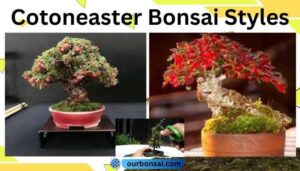
Frequently Asked Questions
What Is The Best Cotoneaster For Bonsai?
Cotoneaster horizontalis is ideal for bonsai due to its small leaves and attractive berries. It offers a good structure and responds well to shaping, making it popular among bonsai enthusiasts. This species is hardy and adaptable, thriving in various conditions.
What Is The Rule Of 3 In Bonsai Trees?
The rule of 3 in bonsai refers to creating balance using three main elements: trunk, branches, and foliage. This principle helps achieve visual harmony and natural aesthetics, guiding the design and shaping process for a well-proportioned bonsai tree.
What Is The Lifespan Of A Cotoneaster Tree?
A Cotoneaster tree typically lives for 20 to 50 years. Proper care can extend its lifespan. Regular pruning and watering support healthy growth. This hardy plant adapts well to various environments, enhancing its longevity. Ensure it receives adequate sunlight for optimal health and a longer life.
What Is The Most Difficult Bonsai Style?
The most difficult bonsai style is the Literati or “Bunjin” style. It requires creating an elegant, sparse tree with a twisted trunk and minimal foliage. Achieving its unique, artistic form demands advanced skills, patience, and creativity, making it challenging for bonsai enthusiasts.
Conclusion
Exploring cotoneaster bonsai styles brings creativity to your garden. Beginners can start with simple styles. Choose the best cotoneaster that suits your skill level.
Cotoneaster Franchetii offers unique features for bonsai enthusiasts. Each style presents beauty and challenge. Experimenting with different styles enhances your gardening experience.
Keep learning to perfect your bonsai art. Enjoy the journey of growing and shaping your cotoneaster bonsai. Your garden will thank you with its beauty. Dive into the world of bonsai and find your style. Happy gardening!
